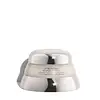What's inside
What's inside
 Key Ingredients
Key Ingredients

 Benefits
Benefits

 Concerns
Concerns

 Ingredients Side-by-side
Ingredients Side-by-side

Rosa Centifolia Flower Water
Skin ConditioningGlycerin
HumectantCaprylic/Capric Triglyceride
MaskingDicaprylyl Carbonate
EmollientCetearyl Alcohol
EmollientHydrogenated Polyisobutene
EmollientWater
Skin ConditioningSodium Polyacrylate
AbsorbentPotassium Cetyl Phosphate
EmulsifyingRosa Hybrid Flower Extract
Skin ConditioningCichorium Intybus Root Oligosaccharides
Skin ConditioningHelianthus Annuus Seed Wax
Skin ConditioningLactobacillus Ferment
Skin ConditioningAcacia Decurrens Flower Wax
EmollientJojoba Esters
EmollientCaesalpinia Spinosa Gum
Skin ConditioningPolyglycerin-3
HumectantSodium Stearoyl Glutamate
CleansingCastor Oil/Ipdi Copolymer
Dilinoleic Acid/Butanediol Copolymer
Coco-Caprylate/Caprate
EmollientTriheptanoin
Skin ConditioningC9-12 Alkane
SolventGluconolactone
Skin ConditioningCalcium Gluconate
HumectantAcetyl Tetrapeptide-2
Skin ConditioningParfum
MaskingCaprylyl Glycol
EmollientGlyceryl Stearate
EmollientTocopheryl Acetate
AntioxidantBenzoic Acid
MaskingChlorphenesin
AntimicrobialP-Anisic Acid
MaskingSodium Benzoate
MaskingPotassium Sorbate
PreservativeBenzyl Alcohol
PerfumingRosa Centifolia Flower Water, Glycerin, Caprylic/Capric Triglyceride, Dicaprylyl Carbonate, Cetearyl Alcohol, Hydrogenated Polyisobutene, Water, Sodium Polyacrylate, Potassium Cetyl Phosphate, Rosa Hybrid Flower Extract, Cichorium Intybus Root Oligosaccharides, Helianthus Annuus Seed Wax, Lactobacillus Ferment, Acacia Decurrens Flower Wax, Jojoba Esters, Caesalpinia Spinosa Gum, Polyglycerin-3, Sodium Stearoyl Glutamate, Castor Oil/Ipdi Copolymer, Dilinoleic Acid/Butanediol Copolymer, Coco-Caprylate/Caprate, Triheptanoin, C9-12 Alkane, Gluconolactone, Calcium Gluconate, Acetyl Tetrapeptide-2, Parfum, Caprylyl Glycol, Glyceryl Stearate, Tocopheryl Acetate, Benzoic Acid, Chlorphenesin, P-Anisic Acid, Sodium Benzoate, Potassium Sorbate, Benzyl Alcohol
Water
Skin ConditioningGlycerin
HumectantButylene Glycol
HumectantIsododecane
EmollientIsohexadecane
EmollientDimethicone
EmollientCetyl Ethylhexanoate
EmollientHydrogenated Polydecene
EmollientDisteardimonium Hectorite
StabilisingPEG-9 Polydimethylsiloxyethyl Dimethicone
EmulsifyingPEG-150
HumectantPEG-8 Diisostearate
EmulsifyingPhenoxyethanol
PreservativeMethylparaben
PreservativeEthylparaben
PreservativePhytosteryl Macadamiate
Skin ConditioningSodium Citrate
BufferingParfum
MaskingTrisodium EDTA
Tocopheryl Acetate
AntioxidantStearyl Glycyrrhetinate
Skin ConditioningHydroxyproline
Skin ConditioningCitric Acid
BufferingSodium Metaphosphate
BufferingBenzyl Benzoate
AntimicrobialAlpha-Isomethyl Ionone
PerfumingButylphenyl Methylpropional
PerfumingHexyl Cinnamal
PerfumingLinalool
PerfumingLimonene
PerfumingSodium Acetylated Hyaluronate
HumectantCitronellol
PerfumingGeraniol
PerfumingSaccharomyces Ferment Lysate Filtrate
Skin ConditioningRubus Idaeus Fruit Extract
AstringentCI 77492
Cosmetic ColorantSyzygium Jambos Leaf Extract
Skin ConditioningCI 77491
Cosmetic ColorantTocopherol
AntioxidantWater, Glycerin, Butylene Glycol, Isododecane, Isohexadecane, Dimethicone, Cetyl Ethylhexanoate, Hydrogenated Polydecene, Disteardimonium Hectorite, PEG-9 Polydimethylsiloxyethyl Dimethicone, PEG-150, PEG-8 Diisostearate, Phenoxyethanol, Methylparaben, Ethylparaben, Phytosteryl Macadamiate, Sodium Citrate, Parfum, Trisodium EDTA, Tocopheryl Acetate, Stearyl Glycyrrhetinate, Hydroxyproline, Citric Acid, Sodium Metaphosphate, Benzyl Benzoate, Alpha-Isomethyl Ionone, Butylphenyl Methylpropional, Hexyl Cinnamal, Linalool, Limonene, Sodium Acetylated Hyaluronate, Citronellol, Geraniol, Saccharomyces Ferment Lysate Filtrate, Rubus Idaeus Fruit Extract, CI 77492, Syzygium Jambos Leaf Extract, CI 77491, Tocopherol
 Reviews
Reviews

Ingredients Explained
These ingredients are found in both products.
Ingredients higher up in an ingredient list are typically present in a larger amount.
Glycerin is already naturally found in your skin. It helps moisturize and protect your skin.
A study from 2016 found glycerin to be more effective as a humectant than AHAs and hyaluronic acid.
As a humectant, it helps the skin stay hydrated by pulling moisture to your skin. The low molecular weight of glycerin allows it to pull moisture into the deeper layers of your skin.
Hydrated skin improves your skin barrier; Your skin barrier helps protect against irritants and bacteria.
Glycerin has also been found to have antimicrobial and antiviral properties. Due to these properties, glycerin is often used in wound and burn treatments.
In cosmetics, glycerin is usually derived from plants such as soybean or palm. However, it can also be sourced from animals, such as tallow or animal fat.
This ingredient is organic, colorless, odorless, and non-toxic.
Glycerin is the name for this ingredient in American English. British English uses Glycerol/Glycerine.
Learn more about GlycerinParfum is a catch-all term for an ingredient or more that is used to give a scent to products.
Also called "fragrance", this ingredient can be a blend of hundreds of chemicals or plant oils. This means every product with "fragrance" or "parfum" in the ingredients list is a different mixture.
For instance, Habanolide is a proprietary trade name for a specific aroma chemical. When used as a fragrance ingredient in cosmetics, most aroma chemicals fall under the broad labeling category of “FRAGRANCE” or “PARFUM” according to EU and US regulations.
The term 'parfum' or 'fragrance' is not regulated in many countries. In many cases, it is up to the brand to define this term.
For instance, many brands choose to label themselves as "fragrance-free" because they are not using synthetic fragrances. However, their products may still contain ingredients such as essential oils that are considered a fragrance by INCI standards.
One example is Calendula flower extract. Calendula is an essential oil that still imparts a scent or 'fragrance'.
Depending on the blend, the ingredients in the mixture can cause allergies and sensitivities on the skin. Some ingredients that are known EU allergens include linalool and citronellol.
Parfum can also be used to mask or cover an unpleasant scent.
The bottom line is: not all fragrances/parfum/ingredients are created equally. If you are worried about fragrances, we recommend taking a closer look at an ingredient. And of course, we always recommend speaking with a professional.
Learn more about ParfumTocopheryl Acetate is AKA Vitamin E. It is an antioxidant and protects your skin from free radicals. Free radicals damage the skin by breaking down collagen.
One study found using Tocopheryl Acetate with Vitamin C decreased the number of sunburned cells.
Tocopheryl Acetate is commonly found in both skincare and dietary supplements.
Learn more about Tocopheryl AcetateWater. It's the most common cosmetic ingredient of all. You'll usually see it at the top of ingredient lists, meaning that it makes up the largest part of the product.
So why is it so popular? Water most often acts as a solvent - this means that it helps dissolve other ingredients into the formulation.
You'll also recognize water as that liquid we all need to stay alive. If you see this, drink a glass of water. Stay hydrated!
Learn more about Water